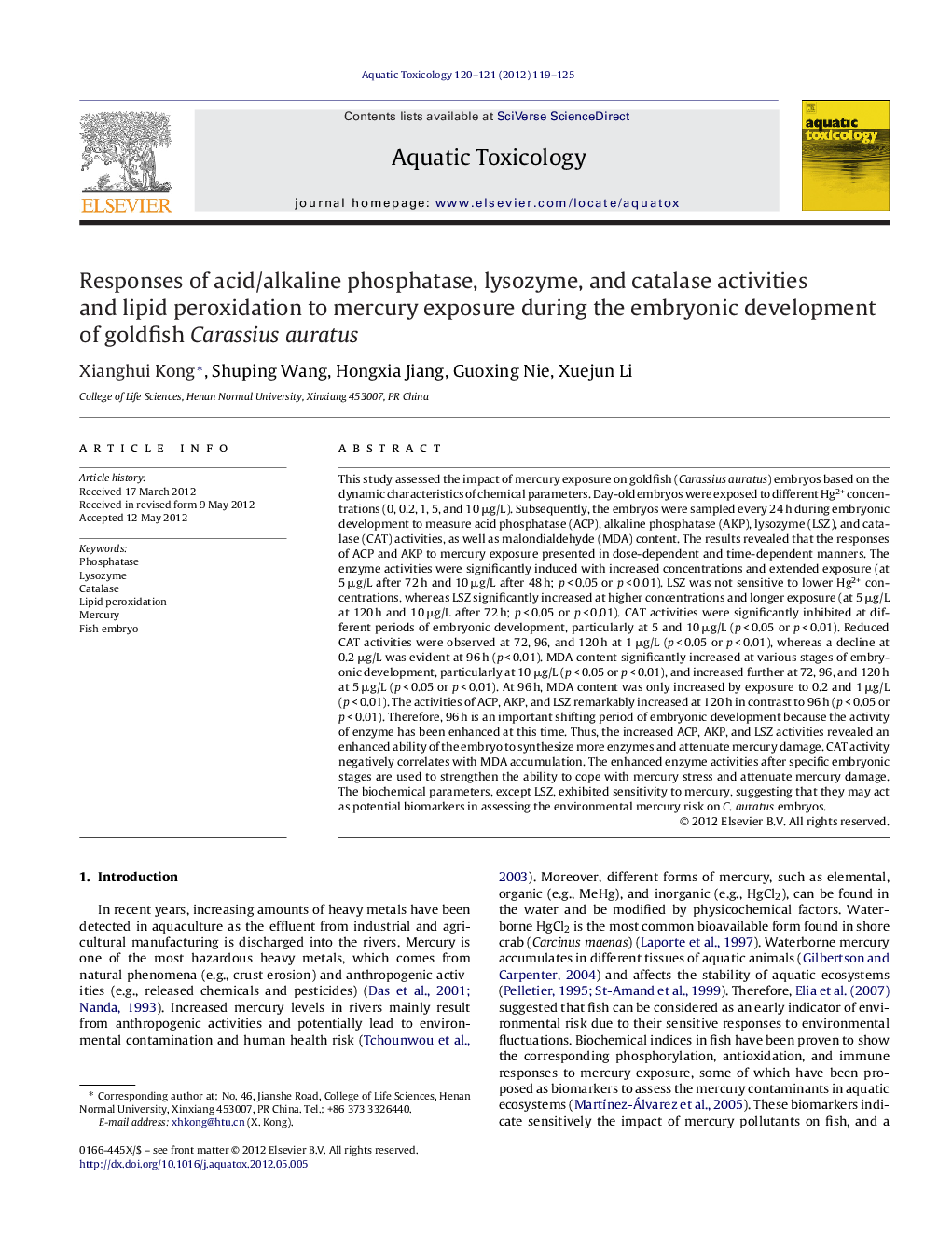| Article ID | Journal | Published Year | Pages | File Type |
|---|---|---|---|---|
| 4529576 | Aquatic Toxicology | 2012 | 7 Pages |
This study assessed the impact of mercury exposure on goldfish (Carassius auratus) embryos based on the dynamic characteristics of chemical parameters. Day-old embryos were exposed to different Hg2+ concentrations (0, 0.2, 1, 5, and 10 μg/L). Subsequently, the embryos were sampled every 24 h during embryonic development to measure acid phosphatase (ACP), alkaline phosphatase (AKP), lysozyme (LSZ), and catalase (CAT) activities, as well as malondialdehyde (MDA) content. The results revealed that the responses of ACP and AKP to mercury exposure presented in dose-dependent and time-dependent manners. The enzyme activities were significantly induced with increased concentrations and extended exposure (at 5 μg/L after 72 h and 10 μg/L after 48 h; p < 0.05 or p < 0.01). LSZ was not sensitive to lower Hg2+ concentrations, whereas LSZ significantly increased at higher concentrations and longer exposure (at 5 μg/L at 120 h and 10 μg/L after 72 h; p < 0.05 or p < 0.01). CAT activities were significantly inhibited at different periods of embryonic development, particularly at 5 and 10 μg/L (p < 0.05 or p < 0.01). Reduced CAT activities were observed at 72, 96, and 120 h at 1 μg/L (p < 0.05 or p < 0.01), whereas a decline at 0.2 μg/L was evident at 96 h (p < 0.01). MDA content significantly increased at various stages of embryonic development, particularly at 10 μg/L (p < 0.05 or p < 0.01), and increased further at 72, 96, and 120 h at 5 μg/L (p < 0.05 or p < 0.01). At 96 h, MDA content was only increased by exposure to 0.2 and 1 μg/L (p < 0.01). The activities of ACP, AKP, and LSZ remarkably increased at 120 h in contrast to 96 h (p < 0.05 or p < 0.01). Therefore, 96 h is an important shifting period of embryonic development because the activity of enzyme has been enhanced at this time. Thus, the increased ACP, AKP, and LSZ activities revealed an enhanced ability of the embryo to synthesize more enzymes and attenuate mercury damage. CAT activity negatively correlates with MDA accumulation. The enhanced enzyme activities after specific embryonic stages are used to strengthen the ability to cope with mercury stress and attenuate mercury damage. The biochemical parameters, except LSZ, exhibited sensitivity to mercury, suggesting that they may act as potential biomarkers in assessing the environmental mercury risk on C. auratus embryos.
► We find response model of enzyme activities to mercury exposure in fish embryo. ► Mercury impacts fish embryo in concentration-depended and time-depended styles. ► Increasing CAT activity can reduce the degree of lipid peroxidation in embryo. ► Serious oxidative stress can occur in embryo at higher mercury concentration. ► Enzyme activity will be enhanced after a specific embryo development period.
